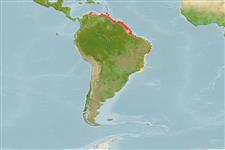>
Siluriformes (Catfishes) >
Ariidae (Sea catfishes) > Ariinae
Etymology: Cathorops: Greek, kathorao = to observe, to watch + Greek, ops = appearance (Ref. 45335); spixii: The name is dedicated to the ichthyologist of the 19th century, J.B. de Spix (Ref. 35381).
More on author: Agassiz.
Environment: milieu / climate zone / depth range / distribution range
Écologie
marin; saumâtre démersal; profondeur 1 - 50 m (Ref. 5217). Tropical; 13°N - 23°S, 77°W - 34°W
Western Atlantic: Atlantic and Caribbean rivers and estuaries from Colombia to Brazil.
Length at first maturity / Taille / Poids / Âge
Maturity: Lm 16.4, range 10 - 22.4 cm
Max length : 30.0 cm TL mâle / non sexé; (Ref. 3265); common length : 20.0 cm TL mâle / non sexé; (Ref. 3265); poids max. publié: 97.50 g (Ref. 118626)
3 pairs of barbels on rostral region, 2 pairs on lower jaw, 1 pair on posterior end of maxilla; body dark brown or black dorsally, pale yellow ventrally; fin membranes brown, with small black spots (Ref. 13608). Head is widely flattened from above, nostril rounded, mouth inferior. The cephalic surface hardly reaches the level of the eyes (Ref. 35381).
Found in shallow coastal marine waters and brackish estuaries, lagoons and river mouths. Also in hypersaline waters (Ref. 5217). Feeds mainly on invertebrates and small fishes. Juveniles feed on amphipods, isopods and copepods (Ref. 35381). Flesh considered good quality (Ref. 5217). Sold locally.
Life cycle and mating behavior
Maturité | Reproduction | Frai | Œufs | Fécondité | Larves
Marceniuk, A.P. and C.J. Ferraris Jr., 2003. Ariidae (Sea catfishes). p. 447-455. In R.E. Reis, S.O. Kullander and C.J. Ferraris, Jr. (eds.) Checklist of the freshwater fishes of South and Central America. Porto Alegre: EDIPUCRS, Brasil. (Ref. 39852)
Statut dans la liste rouge de l'IUCN (Ref. 130435)
Menace pour l'homme
Traumatogenic (Ref. 58010)
Utilisations par l'homme
Pêcheries: intérêt commercial mineur
Plus d'informations
RéférencesAquacultureProfil d'aquacultureSouchesGénétiqueElectrophoresesHéritabilitéPathologiesTraitementNutrientsMass conversion
CollaborateursImagesStamps, Coins Misc.SonsCiguateraVitesseType de nageSurface branchialeOtolithesCerveauxVision
Outils
Articles particuliers
Télécharger en XML
Sources Internet
Estimates based on models
Preferred temperature (Ref.
123201): 24.9 - 28.2, mean 27.4 °C (based on 118 cells).
Phylogenetic diversity index (Ref.
82804): PD
50 = 0.5000 [Uniqueness, from 0.5 = low to 2.0 = high].
Bayesian length-weight: a=0.00724 (0.00611 - 0.00858), b=3.04 (2.99 - 3.09), in cm total length, based on LWR estimates for this species (Ref.
93245).
Niveau trophique (Ref.
69278): 3.5 ±0.1 se; based on diet studies.
Résilience (Ref.
120179): Milieu, temps minimum de doublement de population : 1,4 à 4,4 années (Preliminary K or Fecundity.).
Fishing Vulnerability (Ref.
59153): Low vulnerability (20 of 100).
Nutrients (Ref.
124155): Calcium = 122 [59, 299] mg/100g; Iron = 1 [1, 2] mg/100g; Protein = 17 [15, 19] %; Omega3 = 0.267 [0.142, 0.513] g/100g; Selenium = 44.3 [21.0, 99.1] μg/100g; VitaminA = 37.5 [12.6, 116.5] μg/100g; Zinc = 1.71 [1.12, 2.74] mg/100g (wet weight);
